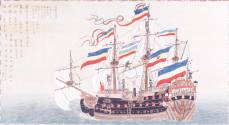Dutch East Indiaman, "Schellack"
Date19th century
Label TextAt the time this ship was painted, the Dutch had been the only European traders permitted in the Japanese port of Nagasaki for two hundred years. From 1639 until 1854 the Japanese policy of sakoku (closed country) limited external trade. During these centuries, Japanese porcelain came to Europe directly from Dutch ships calling in Nagasaki or from Chinese imports of Japanese porcelain, which were then traded west.
Object number60.78
Photo CreditPhoto: Paul Macapia
Exhibition HistorySeattle, Washington, Seattle Asian Art Museum, Legends, Tales, Poetry: Visual Narrative in Japanese Art, December 22, 2012 - July 21, 2013
Seattle, Washington, Seattle Art Museum, "Documents International: Reflections in the Mirror: A World of Identity", April 23, 1998 - June 20, 1999
Seattle, Washington, Seattle Art Museum, "Porcelain Stories: From China to Europe", February 17, 2000-May 7, 2000 (2/17/2000 - 5/7/2000)
Seattle, Washington, Seattle Art Museum, "Refined Harmony: Decorative Arts from the Edo Period", March 7, 2003 - March 23, 2004
Seattle, Washington, Seattle Art Museum, "Japan Envisions the West: 16th - 19th Century Japanese Art from the Kobe City Museum", October 7, 2007 - January 8, 2008 (10/7/2007 - 1/8/2008)Published ReferencesFuller, Richard E. "Japanese Art in the Seattle Art Museum: An Historical Sketch." Seattle, WA: Seattle Art Museum, 1960 ("Presented in commemoration of the Hundredth Anniversary of Diplomatic Relations between Japan and the United States of America"), no. 169
Credit LineEugene Fuller Memorial Collection
Dimensions12 1/2 x 23 3/8 in. (31.75 x 59.37 cm)
MediumColor on paper
Miyagawa School
mid-1700s
Object number: 62.133.1
Miyagawa School
mid-1700s
Object number: 62.133.2













 log in
log in



